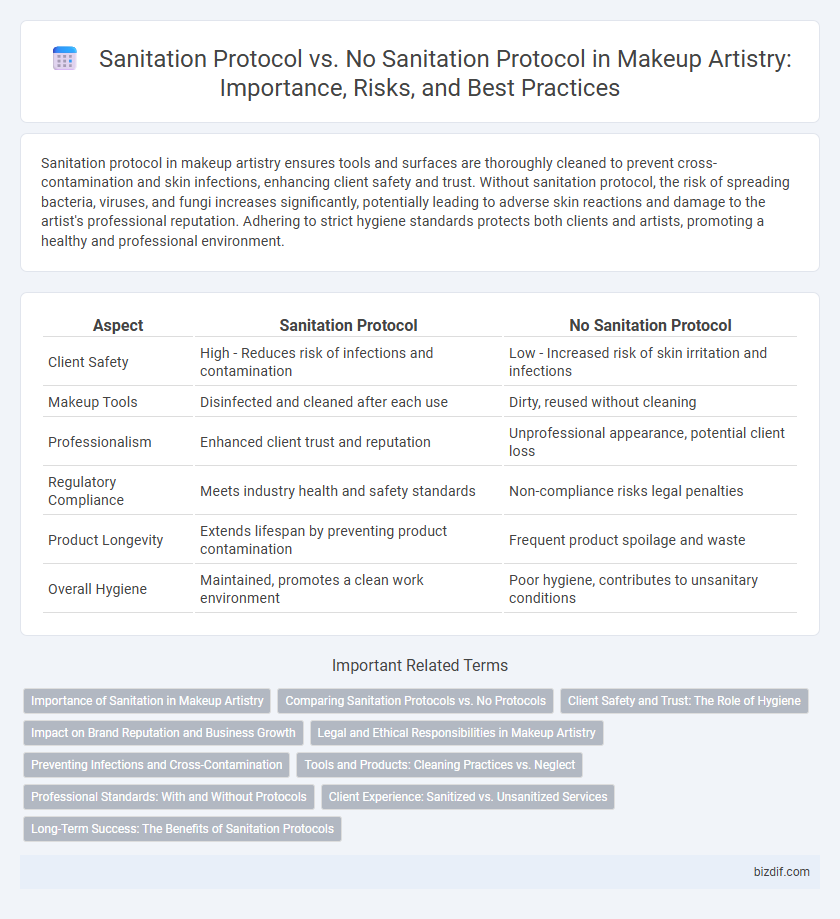Sanitation protocol in makeup artistry ensures tools and surfaces are thoroughly cleaned to prevent cross-contamination and skin infections, enhancing client safety and trust. Without sanitation protocol, the risk of spreading bacteria, viruses, and fungi increases significantly, potentially leading to adverse skin reactions and damage to the artist's professional reputation. Adhering to strict hygiene standards protects both clients and artists, promoting a healthy and professional environment.
Table of Comparison
| Aspect | Sanitation Protocol | No Sanitation Protocol |
|---|---|---|
| Client Safety | High - Reduces risk of infections and contamination | Low - Increased risk of skin irritation and infections |
| Makeup Tools | Disinfected and cleaned after each use | Dirty, reused without cleaning |
| Professionalism | Enhanced client trust and reputation | Unprofessional appearance, potential client loss |
| Regulatory Compliance | Meets industry health and safety standards | Non-compliance risks legal penalties |
| Product Longevity | Extends lifespan by preventing product contamination | Frequent product spoilage and waste |
| Overall Hygiene | Maintained, promotes a clean work environment | Poor hygiene, contributes to unsanitary conditions |
Importance of Sanitation in Makeup Artistry
Sanitation protocols in makeup artistry significantly reduce the risk of cross-contamination and the spread of bacteria, ensuring client safety and maintaining professional standards. Without proper sanitation, makeup tools and products can harbor harmful pathogens, leading to skin infections and allergic reactions. Adhering to strict hygiene practices enhances the reputation of makeup artists and promotes long-term client trust and satisfaction.
Comparing Sanitation Protocols vs. No Protocols
Proper sanitation protocols in makeup artistry significantly reduce the risk of cross-contamination and skin infections by ensuring tools and products are regularly sterilized. In contrast, the absence of sanitation protocols increases the likelihood of bacterial growth and allergic reactions, compromising client safety and the artist's professional reputation. Adhering to strict hygiene standards not only protects clients but also enhances the longevity and quality of makeup applications.
Client Safety and Trust: The Role of Hygiene
Strict sanitation protocols in makeup artistry significantly enhance client safety by reducing the risk of infections and cross-contamination. Adhering to hygiene standards builds trust and assures clients that their health is a priority. Makeup artists who neglect sanitation risk damaging their reputation and losing client confidence.
Impact on Brand Reputation and Business Growth
Implementing strict sanitation protocols in makeup artistry significantly enhances brand reputation by fostering client trust and demonstrating professionalism, leading to positive reviews and repeat business. Conversely, neglecting sanitation standards risks health hazards and negative publicity, which can damage customer loyalty and stunt business growth. Consistent hygiene practices directly contribute to a sustainable competitive advantage and long-term profitability in the beauty industry.
Legal and Ethical Responsibilities in Makeup Artistry
Following sanitation protocols in makeup artistry is a critical legal and ethical responsibility that protects clients from infections and cross-contamination. Failure to implement these standards can result in legal actions, including fines or license revocation, and damages the artist's professional reputation. Adhering to proper sanitation not only ensures compliance with health regulations but also upholds the integrity and trust essential in the beauty industry.
Preventing Infections and Cross-Contamination
Strict sanitation protocols in makeup artistry are essential for preventing infections and minimizing cross-contamination risks, ensuring client safety by using sterilized tools and disposable applicators. Without sanitation protocols, there is a heightened risk of bacterial and viral transmission, potentially causing skin irritations, allergic reactions, or more severe infections. Maintaining rigorous hygiene standards protects both artists and clients, fostering a professional and trustworthy environment.
Tools and Products: Cleaning Practices vs. Neglect
Proper sanitation protocols in makeup artistry require thorough cleaning and sterilization of tools and products after each use, significantly reducing the risk of cross-contamination and skin infections. In contrast, neglecting sanitation allows bacteria and residue to accumulate on brushes, sponges, and makeup containers, compromising client safety and product integrity. Consistent adherence to sanitation standards ensures hygienic application, preserving both artist reputation and client health.
Professional Standards: With and Without Protocols
Implementing sanitation protocols in makeup artistry ensures adherence to professional standards, significantly reducing the risk of cross-contamination and client infections. Without established sanitation protocols, artists compromise hygiene, potentially causing adverse skin reactions and damaging their professional reputation. Consistent sanitation practices demonstrate commitment to client safety and elevate industry credibility.
Client Experience: Sanitized vs. Unsanitized Services
Sanitized makeup artistry services significantly enhance client experience by minimizing the risk of infections and ensuring a hygienic environment, which builds trust and encourages repeat bookings. In contrast, unsanitized setups often cause discomfort and raise safety concerns, undermining client confidence and potentially leading to negative reviews. Strict sanitation protocols, including sterilizing brushes and tools, contribute to a professional atmosphere that prioritizes client health and satisfaction.
Long-Term Success: The Benefits of Sanitation Protocols
Implementing strict sanitation protocols in makeup artistry significantly reduces the risk of skin infections and allergic reactions, ensuring client safety and satisfaction over time. Consistent sanitation practices protect the artist's reputation and build trust, which are essential for long-term business growth and client retention. Conversely, neglecting sanitation increases the likelihood of contamination and client complaints, ultimately jeopardizing the artist's professional longevity and success.
Sanitation protocol vs No sanitation protocol Infographic

 bizdif.com
bizdif.com